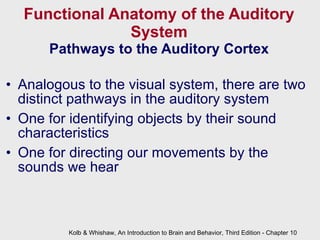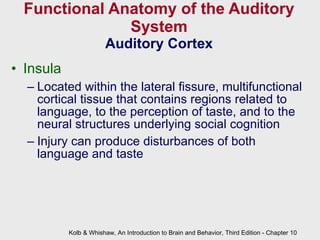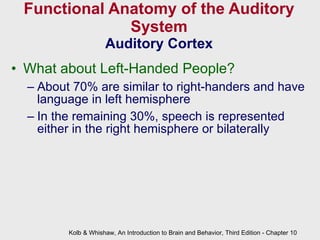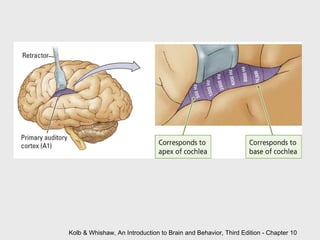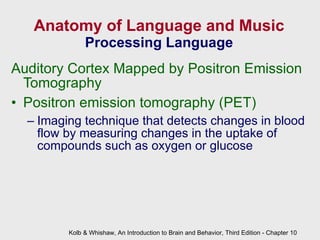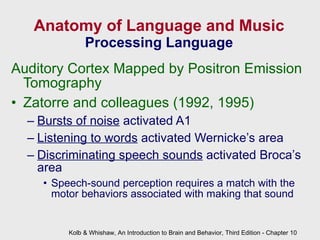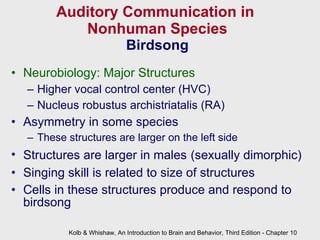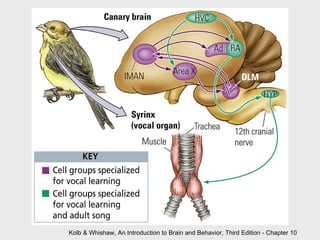B and b3 lec ppt_ch10
- 1. How Do We Hear, Speak, and Make Music? An Introduction to Brain and Behavior Third Edition CHAPTER 10 PowerPoints prepared by: Paul Smaldino, UC Davis, Department of Psychology Bryan Kolb & Ian Q. Whishaw
- 2. How Do We Hear, Speak, and Make Music? Sound Waves: The Stimulus for Audition Functional Anatomy of the Auditory System Neural Activity and Hearing Anatomy of Language and Music Auditory Communication in Nonhuman Species Kolb & Whishaw, An Introduction to Brain and Behavior, Third Edition - Chapter 10
- 3. Sound Waves: The Stimulus for Audition Sound Wave Undulating displacement of molecules caused by changing pressure Kolb & Whishaw, An Introduction to Brain and Behavior, Third Edition - Chapter 10
- 4. Kolb & Whishaw, An Introduction to Brain and Behavior, Third Edition - Chapter 10
- 5. Sound Waves: The Stimulus for Audition Physical Properties of Sound Waves Three Properties of Sound-Wave Energy 1) Frequency Number of cycles that a wave completes in a given amount of time Measured in Hertz : Cycles per second Corresponds to our perception of pitch Low pitch: low frequency High pitch: high frequency Kolb & Whishaw, An Introduction to Brain and Behavior, Third Edition - Chapter 10
- 6. Kolb & Whishaw, An Introduction to Brain and Behavior, Third Edition - Chapter 10
- 7. Sound Waves: The Stimulus for Audition Physical Properties of Sound Waves 2) Amplitude The intensity of a sound stimulus, usually measured in decibels (dB) The magnitude of change in air-molecule density Corresponds to our perception of loudness Soft sound: Low amplitude Loud sound: High amplitude Kolb & Whishaw, An Introduction to Brain and Behavior, Third Edition - Chapter 10
- 8. Kolb & Whishaw, An Introduction to Brain and Behavior, Third Edition - Chapter 10
- 9. Sound Waves: The Stimulus for Audition Physical Properties of Sound Waves 3) Complexity Pure tones Sounds with a single frequency Complex tones Sounds with a mixture of frequencies Corresponds to our perception of timbre or uniqueness How we can distinguish between a trombone and violin playing the same note Kolb & Whishaw, An Introduction to Brain and Behavior, Third Edition - Chapter 10
- 10. Sound Waves: The Stimulus for Audition Physical Properties of Sound Waves 3) Complexity Fundamental Frequency The rate at which the complex waveform pattern repeats Overtones Set of higher frequency sound waves that vibrate at whole-number (integer) multiples of the fundamental frequency Kolb & Whishaw, An Introduction to Brain and Behavior, Third Edition - Chapter 10
- 11. Kolb & Whishaw, An Introduction to Brain and Behavior, Third Edition - Chapter 10 [Insert Fig. 10-6]
- 12. Kolb & Whishaw, An Introduction to Brain and Behavior, Third Edition - Chapter 10
- 13. Sound Waves: The Stimulus for Audition Perception of Sound Auditory system converts the physical properties of sound-wave energy into electrochemical neural activity that travels to the brain Sounds are products of the brain Our sensitivity to sound waves is extraordinary Detect the displacement of air molecules of about 10 picometers (10 -11 m) Kolb & Whishaw, An Introduction to Brain and Behavior, Third Edition - Chapter 10
- 14. Sound Waves: The Stimulus for Audition Properties of Language and Music as Sounds Language and music both convey meaning and evoke emotion Left temporal lobe analyzes speech for meaning Right temporal lobe analyzes musical sounds for meaning Language facilitates communication Music helps us to regulate our emotions and affect the emotions of others Kolb & Whishaw, An Introduction to Brain and Behavior, Third Edition - Chapter 10
- 15. Sound Waves: The Stimulus for Audition Properties of Language and Music as Sounds Properties of Language We hear variations of a sound as if they were identical Unique to perception of speech sounds The auditory system has a mechanism for categorizing sounds as the same despite small differences in pronunciation Makes learning foreign languages later in life more difficult Kolb & Whishaw, An Introduction to Brain and Behavior, Third Edition - Chapter 10
- 16. Sound Waves: The Stimulus for Audition Properties of Language and Music as Sounds Properties of Music Loudness “Very loud” to some is only “moderately loud” to others Pitch Defined as the fundamental frequency, regardless of timbre Quality The timbre of a sound, regardless of pitch Kolb & Whishaw, An Introduction to Brain and Behavior, Third Edition - Chapter 10
- 17. Functional Anatomy of the Auditory System Structure of the Ear Outer Ear Pinna Funnel-like external structure designed to catch sound waves in the surrounding environment and deflect them into the ear canal External Ear Canal Amplifies sound waves somewhat and directs them to the eardrum, which vibrates in accordance with the frequency of the sound wave Kolb & Whishaw, An Introduction to Brain and Behavior, Third Edition - Chapter 10
- 18. Functional Anatomy of the Auditory System Structure of the Ear Middle Ear Air-filled chamber that comprises the ossicles Ossicles Bones in the middle ear: Hammer Anvil Stirrup Connects the eardrum to the oval window of the cochlea, located in the inner ear Kolb & Whishaw, An Introduction to Brain and Behavior, Third Edition - Chapter 10
- 19. Functional Anatomy of the Auditory System Structure of the Ear Inner Ear Cochlea Fluid-filled inner-ear structure that contains the auditory receptor cells Organ of Corti: receptor cells and the cells that support them Basilar membrane Receptor surface in the cochlea that transduces sound waves into neural activity Kolb & Whishaw, An Introduction to Brain and Behavior, Third Edition - Chapter 10
- 20. Functional Anatomy of the Auditory System Structure of the Ear Inner Ear Hair Cells Sensory neurons in the cochlea tipped by cilia When stimulated by waves in the cochlear fluid, outer hair cells generate graded potentials in inner hair cells, which act as the auditory receptor cells Tectorial Membrane Membrane overlying hair cells Kolb & Whishaw, An Introduction to Brain and Behavior, Third Edition - Chapter 10
- 21. Kolb & Whishaw, An Introduction to Brain and Behavior, Third Edition - Chapter 10 [Insert Fig. 10-8]
- 22. Functional Anatomy of the Auditory System Structure of the Ear George von B é k é sy (1960s) Sound waves produced a traveling wave that moved all along the basilar membrane Mapped the responsiveness of the basilar membrane to different frequencies Fast wave frequencies : caused maximum displacement near the base of the membrane Slower wave frequencies: caused maximum displacement near the membrane’s apex Kolb & Whishaw, An Introduction to Brain and Behavior, Third Edition - Chapter 10
- 23. Kolb & Whishaw, An Introduction to Brain and Behavior, Third Edition - Chapter 10
- 24. Functional Anatomy of the Auditory System Auditory Receptors Transduction of sound waves into neural activity takes place in the hair cells 3500 inner hair cells (auditory receptors) 12,000 outer hair cells (alters stiffness of tectorial membrane) Movement of the basilar membrane stimulates the hair cells via bending and shearing action Movement of cilia on hair cells changes membrane potential and alters neurotransmitter release Kolb & Whishaw, An Introduction to Brain and Behavior, Third Edition - Chapter 10
- 25. Kolb & Whishaw, An Introduction to Brain and Behavior, Third Edition - Chapter 10
- 26. Functional Anatomy of the Auditory System Auditory Receptors Movement of cilia toward the tallest cilia depolarizes the cell, causing calcium influx and release of neurotransmitter, which stimulates cells that form the auditory nerve Movement of cilia toward the shortest cilia hyperpolarizes the cell, resulting in less neurotransmitter release Kolb & Whishaw, An Introduction to Brain and Behavior, Third Edition - Chapter 10
- 27. Functional Anatomy of the Auditory System Pathways to the Auditory Cortex Inner hair cells synapse onto bipolar cells that form the auditory nerve (part of the 8th cranial nerve) Hindbrain Dorsal and Ventral Cochlear Nucleus Superior Olivary Complex Trapezoid Body Midbrain Inferior Colliculus Kolb & Whishaw, An Introduction to Brain and Behavior, Third Edition - Chapter 10
- 28. Functional Anatomy of the Auditory System Pathways to the Auditory Cortex Thalamus Medial Geniculate Nucleus (MGN) Ventral region projects to Primary Auditory Cortex (A1) Dorsal regions project to cortical regions adjacent to A1 Cerebral Cortex Primary Auditory Cortex (A1) Asymmetrical structures, found within Heschl’s gyrus in the temporal lobes, that receive input from the ventral MGN Kolb & Whishaw, An Introduction to Brain and Behavior, Third Edition - Chapter 10
- 29. Kolb & Whishaw, An Introduction to Brain and Behavior, Third Edition - Chapter 10
- 30. Functional Anatomy of the Auditory System Pathways to the Auditory Cortex Analogous to the visual system, there are two distinct pathways in the auditory system One for identifying objects by their sound characteristics One for directing our movements by the sounds we hear Kolb & Whishaw, An Introduction to Brain and Behavior, Third Edition - Chapter 10
- 31. Functional Anatomy of the Auditory System Auditory Cortex A1 lies within Heschl’s gyrus and is surrounded by secondary auditory cortical areas Wernicke’s area Secondary auditory cortex (planum temporale) lying behind Heschl’s gyrus (A1) at the rear of the left temporal lobe that regulates language comprehension; also called the posterior speech zone Kolb & Whishaw, An Introduction to Brain and Behavior, Third Edition - Chapter 10
- 32. Anatomy of the Auditory System Auditory Cortex Lateralization Process whereby functions become localized primarily on one side of the brain Analysis of speech takes place largely in the left hemisphere Analysis of musical sounds takes place largely in the right hemisphere Kolb & Whishaw, An Introduction to Brain and Behavior, Third Edition - Chapter 10
- 33. Functional Anatomy of the Auditory System Auditory Cortex Insula Located within the lateral fissure, multifunctional cortical tissue that contains regions related to language, to the perception of taste, and to the neural structures underlying social cognition Injury can produce disturbances of both language and taste Kolb & Whishaw, An Introduction to Brain and Behavior, Third Edition - Chapter 10
- 34. Functional Anatomy of the Auditory System Auditory Cortex What about Left-Handed People? About 70% are similar to right-handers and have language in left hemisphere In the remaining 30%, speech is represented either in the right hemisphere or bilaterally Kolb & Whishaw, An Introduction to Brain and Behavior, Third Edition - Chapter 10
- 35. Kolb & Whishaw, An Introduction to Brain and Behavior, Third Edition - Chapter 10
- 36. Neural Activity and Hearing Hearing Pitch Tonotopic Representation Property of audition in which sound waves are processed in a systematic fashion from lower to higher frequencies Low frequencies are processed first by cells on the apex of the basilar membrane and eventually by cells located in the anterior portion of A1 High frequencies are processed first by cells on the base of the basilar membrane and eventually by cells located in the posterior portion of A1 Kolb & Whishaw, An Introduction to Brain and Behavior, Third Edition - Chapter 10
- 37. Kolb & Whishaw, An Introduction to Brain and Behavior, Third Edition - Chapter 10
- 38. Neural Activity and Hearing Hearing Pitch Cochlear Implant Electronic device implanted surgically into the inner ear to transduce sound waves into neural activity and allow deaf people to hear What about very low frequencies? Tonotopic theory does not explain how sounds below 200 Hz are coded Sounds in this range stimulate all cells on the very apex of the basilar membrane Rate of firing is proportional to frequency Kolb & Whishaw, An Introduction to Brain and Behavior, Third Edition - Chapter 10
- 39. Neural Activity and Hearing Detecting Loudness The greater the amplitude of the incoming sound waves, the greater the firing rate of bipolar cells in the cochlea More intense sound waves trigger more intense movements of the basilar membrane, which results in greater shearing action of the hair cells, which leads to more neurotransmitter release onto bipolar cells Kolb & Whishaw, An Introduction to Brain and Behavior, Third Edition - Chapter 10
- 40. Neural Activity and Hearing Detecting Location Medial Part of the Superior Olivary Complex Cells in each hemisphere receive inputs from both ears and calculate the difference in arrival times between the two ears More difficult to compare the inputs when sounds move from the side of the head toward the middle: difference in arrival times is smaller When we detect no difference in arrival times, we infer the sound is coming from directly in front of us or behind us Kolb & Whishaw, An Introduction to Brain and Behavior, Third Edition - Chapter 10
- 41. Neural Activity and Hearing Detecting Location Lateral Part of the Superior Olive and Trapezoid Body Source of sound is detected by the relative loudness on the left or on the right side of the head Since high frequency sound waves do not easily bend around the head, the head acts as an obstacle As a result, higher frequency sound waves on one side of the head are louder than on the other Kolb & Whishaw, An Introduction to Brain and Behavior, Third Edition - Chapter 10
- 42. Kolb & Whishaw, An Introduction to Brain and Behavior, Third Edition - Chapter 10
- 43. Neural Activity and Hearing Detecting Patterns in Sound Music and language are perhaps the primary sound-wave patterns that humans recognize Music = right hemisphere Language = left hemisphere Most research on audition comes from nonhuman primates Example: Neurons in auditory cortex of the squirrel monkey are responsive to vocalizations made by other squirrel monkeys Winter & Funkenstein (1971) Kolb & Whishaw, An Introduction to Brain and Behavior, Third Edition - Chapter 10
- 44. Anatomy of Language and Music Processing Language Evidence for a Genetic Basis of Language (Chomsky, Pinker) 1) Language is universal in human populations 2) Humans learn language early in life and seemingly without effort There is likely a sensitive period for language acquisition that is from about 1 to 6 years of age 3) Languages have many structural elements in common Examples: syntax and grammar Kolb & Whishaw, An Introduction to Brain and Behavior, Third Edition - Chapter 10
- 45. Anatomy of Language and Music Processing Language Localization of Language in the Brain Broca’s area Anterior speech area in the left hemisphere that functions with the motor cortex to produce the movements needed for speaking Wernicke’s area Posterior speech area at the rear of the left temporal lobe that regulates language comprehension; also called the posterior speech zone Kolb & Whishaw, An Introduction to Brain and Behavior, Third Edition - Chapter 10
- 46. Kolb & Whishaw, An Introduction to Brain and Behavior, Third Edition - Chapter 10
- 47. Anatomy of Language and Music Processing Language Aphasia Inability to speak or comprehend language despite the presence of normal comprehension or intact vocal mechanisms Broca’s aphasia is the inability to speak fluently despite the presence of normal comprehension and intact vocal mechanisms Wernicke’s aphasia is inability to understand or to produce meaningful language even though the production of words is still intact Kolb & Whishaw, An Introduction to Brain and Behavior, Third Edition - Chapter 10
- 48. Anatomy of Language and Music Processing Language Auditory and Speech Zones Mapped by Brain Stimulation 1930s: Wilder Penfield (Neurosurgeon) Four Important Cortical Regions for Control of Language Broca’s area Wernicke’s area Dorsal areas of the frontal lobes Motor and somatosensory areas that control facial, tongue, and throat muscles and sensations Kolb & Whishaw, An Introduction to Brain and Behavior, Third Edition - Chapter 10
- 49. Kolb & Whishaw, An Introduction to Brain and Behavior, Third Edition - Chapter 10
- 50. Anatomy of Language and Music Processing Language Auditory and Speech Zones Mapped by Brain Stimulation 1930s: Wilder Penfield (Neurosurgeon) Supplementary Speech Area Speech production region on the dorsal surface of the left frontal lobe Stimulation produces speech arrest Stimulation could elicit vocalizations but not coherent speech (“ speech arrest ”) Kolb & Whishaw, An Introduction to Brain and Behavior, Third Edition - Chapter 10
- 51. Anatomy of Language and Music Processing Language Auditory Cortex Mapped by Positron Emission Tomography Positron emission tomography (PET) Imaging technique that detects changes in blood flow by measuring changes in the uptake of compounds such as oxygen or glucose Kolb & Whishaw, An Introduction to Brain and Behavior, Third Edition - Chapter 10
- 52. Anatomy of Language and Music Processing Language Auditory Cortex Mapped by Positron Emission Tomography Zatorre and colleagues (1992, 1995) Bursts of noise activated A1 Listening to words activated Wernicke’s area Discriminating speech sounds activated Broca’s area Speech-sound perception requires a match with the motor behaviors associated with making that sound Kolb & Whishaw, An Introduction to Brain and Behavior, Third Edition - Chapter 10
- 53. Kolb & Whishaw, An Introduction to Brain and Behavior, Third Edition - Chapter 10
- 54. Anatomy of Language and Music Processing Music Music processing is largely a right-hemisphere specialization However, the left hemisphere plays some role in certain aspects of music processing, especially those that have to do with making music (e.g.,recognizing written music, playing instruments, and composing) Kolb & Whishaw, An Introduction to Brain and Behavior, Third Edition - Chapter 10
- 55. Anatomy of Language and Music Processing Music Zatorre and colleagues (1994): PET Study Bursts of noise activated A1 Listening to melodies activated the secondary auditory cortex of the right hemisphere with some minor activation of same region in left hemisphere Comparing pitches activated the right frontal lobe Kolb & Whishaw, An Introduction to Brain and Behavior, Third Edition - Chapter 10
- 56. Anatomy of Language and Music Processing Music Like language, the capacity for music may be innate Infants show learning preferences for musical scales versus random notes Children and adults are very sensitive to musical errors: Biased toward perceiving regularity in rhythms? Kolb & Whishaw, An Introduction to Brain and Behavior, Third Edition - Chapter 10
- 57. Auditory Communication in Nonhuman Species Birdsong Functions Attracting mates, demarcating territories, and announcing locations Similarities to Human Language Innate, but influenced heavily by experience Great diversity (e.g., the number of songs and the number of syllables within songs varies across species) Sensitive period for acquisition Kolb & Whishaw, An Introduction to Brain and Behavior, Third Edition - Chapter 10
- 58. Kolb & Whishaw, An Introduction to Brain and Behavior, Third Edition - Chapter 10
- 59. Auditory Communication in Nonhuman Species Birdsong Neurobiology: Major Structures Higher vocal control center (HVC) Nucleus robustus archistriatalis (RA) Asymmetry in some species These structures are larger on the left side Structures are larger in males (sexually dimorphic) Singing skill is related to size of structures Cells in these structures produce and respond to birdsong Kolb & Whishaw, An Introduction to Brain and Behavior, Third Edition - Chapter 10
- 60. Kolb & Whishaw, An Introduction to Brain and Behavior, Third Edition - Chapter 10
- 61. Auditory Communication in Nonhuman Species Echolocation in Bats Echolocation Ability to identify and locate an object by bouncing sound waves off object Locate targets and analyze features of the target and the environment Analysis of the differences in return times of echoes is key Echoes differ with respect to an object’s distance and texture Kolb & Whishaw, An Introduction to Brain and Behavior, Third Edition - Chapter 10
- 62. Auditory Communication in Nonhuman Species Echolocation in Bats Many sound waves emitted by bats are at frequencies too high for us to hear Example: 12,000 to 200,000 Hz Different cortical areas process different aspects of echo-related information Distance of targets Velocity of moving targets Kolb & Whishaw, An Introduction to Brain and Behavior, Third Edition - Chapter 10










![Kolb & Whishaw, An Introduction to Brain and Behavior, Third Edition - Chapter 10 [Insert Fig. 10-6]](https://image.slidesharecdn.com/bandb3lecpptch10-110414125022-phpapp01/85/B-and-b3-lec-ppt_ch10-11-320.jpg)


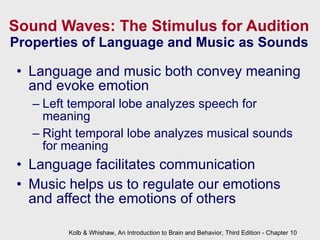






![Kolb & Whishaw, An Introduction to Brain and Behavior, Third Edition - Chapter 10 [Insert Fig. 10-8]](https://image.slidesharecdn.com/bandb3lecpptch10-110414125022-phpapp01/85/B-and-b3-lec-ppt_ch10-21-320.jpg)








